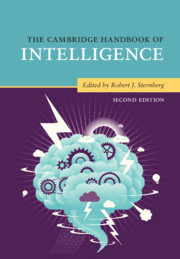Book contents
- The Cambridge Handbook of Intelligence
- The Cambridge Handbook of Intelligence
- Copyright page
- Dedication
- Contents
- Figures
- Tables
- Contributors
- Preface
- Part I Intelligence and Its Measurement
- Part II Development of Intelligence
- Part III Intelligence and Group Differences
- Part IV Biology of Intelligence
- Part V Intelligence and Information Processing
- Part VI Kinds of Intelligence
- 27 The Theory of Multiple Intelligences
- 28 The Augmented Theory of Successful Intelligence
- 29 Emotional Intelligence
- 30 Practical Intelligence
- 31 Social Intelligence
- 32 Collective Intelligence
- 33 Leadership Intelligence
- 34 Cultural Intelligence
- 35 Mating Intelligence
- 36 Consumer and Marketer Intelligence
- Part VII Intelligence and Its Role in Society
- Part VIII Intelligence and Allied Constructs
- Part IX Folk Conceptions of Intelligence
- Part X Conclusion
- Author Index
- Subject Index
- References
35 - Mating Intelligence
from Part VI - Kinds of Intelligence
Published online by Cambridge University Press: 13 December 2019
- The Cambridge Handbook of Intelligence
- The Cambridge Handbook of Intelligence
- Copyright page
- Dedication
- Contents
- Figures
- Tables
- Contributors
- Preface
- Part I Intelligence and Its Measurement
- Part II Development of Intelligence
- Part III Intelligence and Group Differences
- Part IV Biology of Intelligence
- Part V Intelligence and Information Processing
- Part VI Kinds of Intelligence
- 27 The Theory of Multiple Intelligences
- 28 The Augmented Theory of Successful Intelligence
- 29 Emotional Intelligence
- 30 Practical Intelligence
- 31 Social Intelligence
- 32 Collective Intelligence
- 33 Leadership Intelligence
- 34 Cultural Intelligence
- 35 Mating Intelligence
- 36 Consumer and Marketer Intelligence
- Part VII Intelligence and Its Role in Society
- Part VIII Intelligence and Allied Constructs
- Part IX Folk Conceptions of Intelligence
- Part X Conclusion
- Author Index
- Subject Index
- References
Summary
From an evolutionary perspective, psychological factors that bear on reproductive success are of particular importance as such factors directly pertain to Darwin’s bottom line. The psychology surrounding human mating, then, is particularly important from a Darwinian perspective. Mating intelligence is a construct that integrates work on mating psychology with work on intelligence. This broad construct is divided into two general sets of abilities: cognitive mating mechanisms (such as the ability to detect romantic interest on the part of a potential mate) and mental fitness indicators (which are outward behavioral displays of intelligence that facilitate successful courtship).
- Type
- Chapter
- Information
- The Cambridge Handbook of Intelligence , pp. 846 - 870Publisher: Cambridge University PressPrint publication year: 2020
References
- 1
- Cited by

